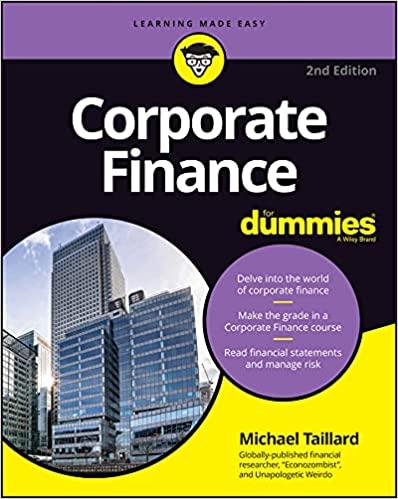Answered step by step
Verified Expert Solution
Question
1 Approved Answer
In Case 20, Fort Greenwold, you solved for Net Present Value using a required rate of return given in the case. In the real world,





In Case 20, Fort Greenwold, you solved for Net Present Value using a required rate of return given in the case. In the real world, the required rate of return for a project (also known as the discount rate or cost of capital) must usually be estimated by the firm.
This week, you will employ the formula for the Weighted Average Cost of Capital (WACC) to estimate the discount rate or required rate of return for a food wholesale company needed to do its capital budgeting.
The process of calculating WACC can be quite time-consuming and error-prone, particularly if like most companies, there are a variety of sources of financing capital in the firm's capital structure (debt, equity, etc). Each of these sources of finance, or securities, must be included in the WACC formula, typically in a separate algebraic term that includes both the percentage of the capital source (out of 100% across all sources) and its unique cost. The only time securities can be combined within a single term in the WACC formula, is when their costs (required returns) are identical.
I have attached a Powerpoint presentation that will take you through the entire process of estimating a company's weighted average cost of capital by considering the firm's various financing securities, the proportion each contributes to the total capital structure, and the individual costs of each security. None of this material should be new for you; however, you may not have had to scan multiple data exhibits, identify and extract the appropriate information in such a rigorous manner before.
Here are a few tips for estimating Taylor Brands' WACC:
1) When calculating the percentages or weights of the various securities, use book values provided in the EXHIBITS.
2) When calculating the total amount of debt, remember to include only longer-term securities, e.g., those that finance capital projects. Do NOT include short-term liabilities like Accounts Payable as these are not considered part of a company's capital structure.
3) Notes Payable must be calculated separately from long-term bonds as they usually have a different cost.
4) The cost (required return) of the company's retained earnings can generally be considered to be the same as that of the company's common stock.
5) The "risk premium approach" to estimating the company's cost of equity is the Capital Asset Pricing Model (CAPM) given in the slides.
6) Estimate the growth rate ('g') of dividends using the data in EXHIBIT 3.
7) Don't forget to consider and include in the formula for WACC, the company's tax rate which acts to reduce the after-tax cost of debt.
Please answer Questions 2(a), 2(b), 3, 5(a), 5(b).
Step by Step Solution
There are 3 Steps involved in it
Step: 1

Get Instant Access to Expert-Tailored Solutions
See step-by-step solutions with expert insights and AI powered tools for academic success
Step: 2

Step: 3

Ace Your Homework with AI
Get the answers you need in no time with our AI-driven, step-by-step assistance
Get Started


